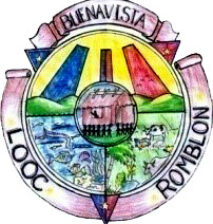The present name of the Barrio is Buenavista. Its earliest name was Carolina named after the beautiful daughter of the first family who founded the barrio.
At the earliest Spanish occupation in the Philippines a representative of the Spanish government named Francisco Maria De Tiran, visited this place and ordered the people to destroy the houses, churches and other buildings built by the natives. This was to annex this barrio to the town of Looc. He really succeeded. This state of being so oppressed, did not last long for the people were very much desirous to go back to their old home. So the people decided to return to the place where they first settled and they named the place “Gubo” by this time. The former Carolina and now which is a part and parcel of the Poblacion of Looc. The name ‘Guba” is attributed to their first barrio which was destroyed by the order of the Spanish Officials. This little barrio of “Guba” is situated near the shore. The inhabitants wanted to expand the area of the place. So they cleared the plateau and constructed dwelling houses there which they called it “Pundar” and as years had passed they called “Punde. Year after year the number of inhabitants increased. At present the barrio is situated on the plateau, an elevated place overlooking the sea. For this reason, the organizer named the place Buenavista instead of Guba.
Buenavista is a Spanish word meaning “Good View” adjacent villages were found due to increase in population. One of the villages Is named “Guintapi-an” meaning “Horizon”, this is because when the sun sets it can be seen clearly from the valley. Another is sitiolalaba which means ‘Oyster” because of the top of its geographical location the shape of the valley resembles that of an Oyster The last sitio is “Bongol” meaning deaf. They also called it such because according to reliable information this sitio was owned by a couple who were all deaf.
In the early days this barrio, was sparsely populated. When the people of Panay heard of the green and fertile soil of “Gt.be which was fitted and suited for Agricultural purpose they flocked in and organized themselves under the leadership of Dor Magallanes. Some people of this barrio came from the neighboring barrios and the rest were immigrants who settled down were the following:
1. Peruchu family
2. Sodoy family
3. Saron family
4. Sombelon family
5. Salivio family
The earliest head of barrio as far as the natives could remember was Cabezalko( Don Francisco Magallanes) the leader and organizer of this barrio was succeeded by the following people until the year 1917.
1. CabezaMaximiano Sodoy
2. Cabeza Mariano Perucho
3. CabezaCenon Conanan
4. Cabeza Leon Salivio
From that year the leadership of the barrio was transferred to the head of barrio called Teniente namely:
1. Mamerto Verden
2. Casimero Osono
3. Placido Gervacio
4. Damaso Gregono S. Mamerto Macabenta
6. Santiago Perucho
In 1920, Jesus Gaa was chosen as the head of the barrio. Then he was succeeded by Teniente Eusebo Sabigan from 1932 to 1934. From 1935 to 1937, Tenienteship was turned over to Mr. Vicente Martino, but after election of 1935, he was elected as one of the councilors. In-Charge of Buenavista, he appointed Roberto Gregorio to be Teniente.
By virtues of the Commonwealth Act 501, which changed the status of the Province of Romblon from regular Province to a special Province, automatically Tablas became special Municipality composing the Municipalities of Badajos, Lespojoes, Odiongan, Looc and Santa Fe, which Odiongan and Looc served as seat of Municipal Government of Tablas. The Mayor whose status was changedto Councilor officially appointed Eugenio Gaa as the Teniente of this barrio until 1942.
When World War 2 was on its height, Teniente Eugenio Gaa was succeeded by Celestino Perucho in 1943, then by Jose Deloviar in 1944 and Monico Zamora who took the stand of Teniente until Liberation time.
In 1945, Mr. Telesforo Gregorio succeeded Monico Zamora until 1950. He was succeeded by Julio Salivio, then Silvestre Aguirre was elected but resigned after one year and Benedicto Gregorio being the Vice Teniente took over. After which, Vicente Deloviar and again Mr. Telesforo Gregono was elected as Barangay Captain where in the Tenienteship was changed to Barangay Captain.
After the death of Telesforo Gregorio, Mr. Pacifico Sabigan Sr. was appointed as Barangay Captain and Mr. Ismael Osorio Sr. succeeded him as Barangay Captain of this barrio until President Ferdinand Marcos was excelled to Honolulu, Hawaii. From then on Revolutionary Government was formed to run Machinery of the government of the Philippines headed by President Corazon Aquino.
All local Chief Executive were all appointed Officer in-Charge and Mr. Jose Nepomuceno was appointed as In-Charge of this barrio. From then on, the set of government process was changed to democratic form of Government. Election was called for Senators, Congressman, local and for Barangay that was on March 28, 1989 and Mr. Mamerto Macabenta was elected as Barangay Captain and after several years he resigned and ran for Sangguniang Sayan Member. Mr. Wenceslao Salmingo was been appointed as OIC Barangay Captain. He was succeeded by Nicanor Gregorio then Ismael Osono Jr. last barangay election, Mr. Rolando Gregorio was elected as Barangay Captain but recently he was removed from the office and at present, Elected Kagawad Fredie Baladjay is appointed as Barangay Captain.






















